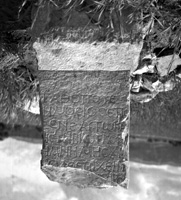 MAMA XI 46 (Eumeneia)
MAMA XI 46 (Eumeneia) 
Funerary bomos of Agathopous, public archivist
- Type of monument:
- Funerary bomos.
- Location:
- Işıklı (Eumeneia): in a field beyond the cemetery.
- Description:
- Plain limestone bomos, broken below, chipped both sides.
- Dimensions:
- Ht. 0.70+; W. 0.34 (upper moulding), 0.29 (shaft); Th. 0.23; letters 0.020-0.030.
- Record:
- WMC notebook copy; photograph (1954/3).
- Publication:
- None.
- Date:
- Roman imperial period.
[Ἀ]γαθόπους
[δ]ημόσιος ἐπο[ί]-
[η]σεν ἑαυτῷ κα[ὶ]
[τ]ῇ συνβίῳ Γρισφε[ί]-
5[ν]ῃ μνήμης χά[ρ]-
[ιν]· ὁ δὲ ἐπιχειρή-
[σας θεῖναι ἕ]τερό[ν]
[τινα- - -]
Agathopous, the public archivist, made (this tomb) for himself and his wife Crispina, in memoriam. He who tries to inter anyone else...




For the name Agathopous at Eumeneia, see Drew-Bear 1978: IV 12 (SEG 28, 1163) and IV 28 (SEG 28, 1124). Agathopous was the public archivist (δημόσιος) at Eumeneia: for tombstones of δημόσιοι in Asia Minor, compare I.Pessinous 86; MAMA I 418 (Orkistos). For the role of the public archivist in recording civic decisions, see Ramsay, Phrygia II 644, no. 544; IGR IV 661.33; AE 2006, 1426.38-9; AE 2006, 1427.13 (all Akmoneia), with Weiss 2004: 70-84. Most, but perhaps not all, were of slave status: see Strubbe’s commentary to I.Pessinous 86. Since Agathopous has no patronym, we may assume that he was a slave. The substitution of gamma for kappa in line 4 is paralleled in e.g. SEG 40, 1041 (Lydia, Iulia Gordos: Γρίσπῳ); see Brixhe 1987: 38, 40-2. For the formula in lines 6-7, compare MAMA IV 340 (Işıklı), ὁ δὲ ἐπιχειρήσας κη[δ]εῦσαι ἕτερόν τινα.